| |
INTERFERON THERAPY FOR CHRONIC HEPATITIS B and Combination Interferon + Lamivudine
|
| |
| |
Robert P. Perrillo, MD
Director, Section of Gastroenterology and Hepatology
Ochsner Clinic Foundation
New Orleans, LA
http://www.meds.com/hepatitis/casebased/perrillo.html
supported by educational grant from GSK
..... Although two large-scale trials have failed to show sustained differences between combination therapy and interferon monotherapy, further research is needed before discounting the possibility that combined therapy may lead to a higher rate of more lasting response..... (ED NOTE from Jules Levin: better designed combination therapy studies may demonstrate added efficacy of two nucleosides or peginterferon plus nucleoside therapy).
Alpha interferon was licensed for hepatitis B in 1992. In the past several years its use has been eclipsed by nucleoside analogue therapy; however, evidence suggests that it continues to bear promise as a treatment for hepatitis B, either alone or in combination with nucleoside analogue therapy. From a theoretical perspective, the different mechanisms of action of interferon and nucleoside analogues should make them complementary to each other. Furthermore, there has been a recent resurgence of interest in interferon with the development of the more potent and longer-acting pegylated forms.
Figure 1 illustrates the life cycle of the hepatitis B virus (HBV).1 The dark and white circles indicate the mechanisms of action of interferon and nucleoside analogues, respectively. Interferon activates intracellular enzymes such as 2'5 oligoadenylate synthetase, resulting in the degradation of HBV mRNA; it also bolsters the cell-mediated immune response to HBV by augmenting expression of HLA class I antigen-presenting molecules on the surfaces of infected hepatocytes. The immunologically relevant viral peptides are located in a peptide-binding cleft on the HLA molecule. In contrast, nucleoside analogues competitively inhibit HBV DNA polymerase, interfering with the synthesis of the first and/or second HBV DNA strand.
Life Cycle
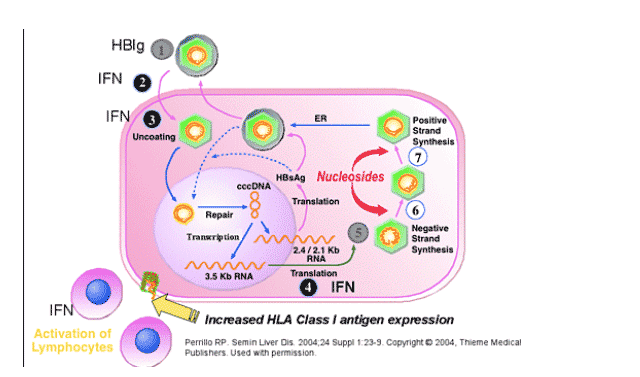
Table 1 lists the advantages and disadvantages of interferon therapy. Several of the beneficial properties (in italics) deserve further comment. First, interferon results in the disappearance of hepatitis B surface antigen (HBsAg) in 5% to 8% of patients within 6 months of treatment. Furthermore, several studies have documented that the frequency of HBsAg clearance in interferon responders increases over time,2 in one study reaching rates of >50% within 5 years.3 In contrast, nucleoside analogue therapy has to be prolonged for several years before HBsAg loss is observed. During the first year or two of nucleoside analogue therapy, the rate of HBsAg loss is comparable to that observed in untreated controls (approximately 1% to 2% per year) (eg, a recent study demonstrated HBsAg loss in 1.6% of patients after 72 weeks of adefovir treatment).4
Table 1. Pros & Cons of Interferon Therapy

Second, drug-resistant mutants have not been described with interferon and, indeed, there are a number of published reports indicating that extension of treatment or retreatment can lead to higher response rates.5,6
Third, interferon is immunomodulatory. Interferon-induced cellular immune responses are thought to result in apoptosis of the infected cell and, although direct evidence is lacking, this probably leads to more effective elimination of the highly resistant closed circular covalent template of HBV DNA (CCC DNA).
A number of studies have shown that the best independent predictors of a response to interferon therapy are the serum HBV DNA and alanine aminotransferase (ALT) levels at baseline. Figure 2 shows data from 41 patients treated with interferon alfa-2b (5 million units/day for 16 weeks). Virologic response (defined as sustained disappearance of HBV DNA and hepatitis B envelope antigen [HbeAg] seroconversion) occurred in only 17% of patients with baseline ALT values <2.5 times the upper limit of normal (ULN) but in 50% of those with baseline ALT ≥5 times ULN. In contrast, there was an inverse relationship between serum HBV DNA and virologic response, with no responses observed among patients whose baseline HBV DNA levels were >200 pg/mL by solution hybridization assay.7 (This corresponds roughly to 56 million copies by polymerase chain reaction (PCR) assay.)
Figure 2
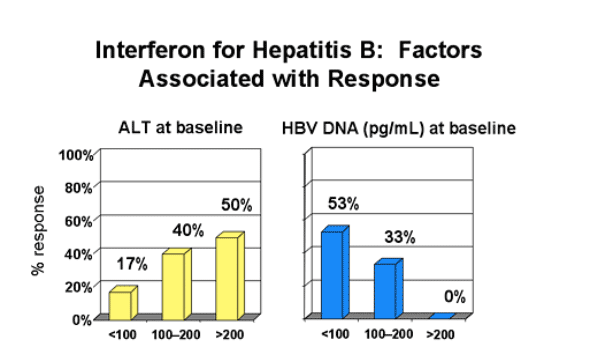
These results suggest that interferon is more effective in patients who have a relatively well preserved cellular immune response to HBV. This conclusion is further supported by a study in which high necroinflammatory scores on liver biopsy correlated with higher rates of virologic response.8
Higher rates of response to interferon have also been shown to correlate with ALT flares during therapy. The relationship between virologic response and the magnitude of ALT flares was evaluated in a cohort of patients with high-level viremia (serum HBV DNA levels >100 pg, or roughly 28 million copies, per mL). Figure 3A shows that, by multivariate analysis, the best independent predictors of response were baseline ALT and severe flares (defined as an increase of >8 times the ULN above baseline). Figure 3B illustrates the virologic response frequencies according to the degree of ALT flare. A striking relationship was observed between the height of the ALT flare and the virologic response.9 These data suggest that robust flares are capable of overcoming the effects of high-level replication and provide some optimism should pegylated interferon prove to have greater immunomodulatory action compared to standard interferon.
Figure 3A. by multivariate analysis, the best independent predictors of response were baseline ALT and severe flares (defined as an increase of >8 times the ULN above baseline)
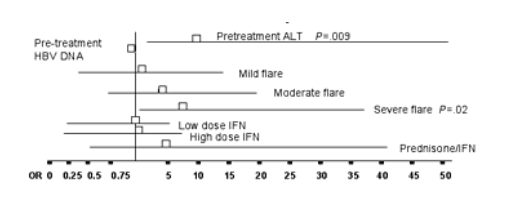
Figure 3B. virologic response frequencies according to the degree of ALT flare
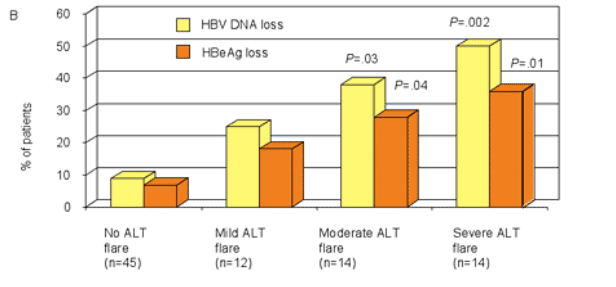
That pegylated interferon is more potent than conventional interferon has been shown in a large randomized trial in Asian patients. Three different doses of pegylated interferon (90, 180, or 270 mg once weekly) were compared with standard interferon (4.5 MIU three times weekly). After 24 weeks of therapy, the patients were followed for 24 weeks off treatment. Endpoints included HBeAg loss, suppression of HBV DNA to <500,000 copies/mL, and ALT normalization. At the end of followup, rates of HBeAg loss were highest in patients receiving the 90-and 180 mg dosages of pegylated interferon (Fig. 4). The percentage of patients achieving all three endpoints was twice as great in all of the pegylated interferon groups combined compared to the group receiving standard interferon.10 (ED NOTE from Jules Levin: a criticism of this study offered by some--10 million units of interferon can be used to treat HBV, so this study did not use this IFN dose).
Figure 4. rates of HBeAg loss were highest in patients receiving the 90-and 180 mg dosages of pegylated interferon
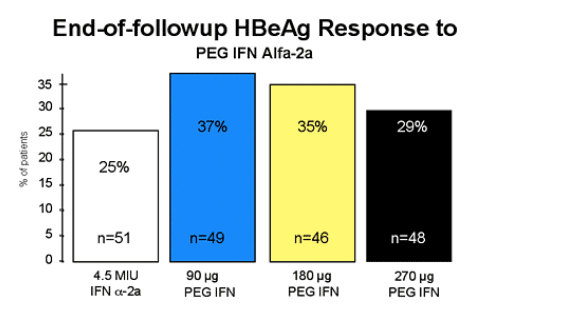
As mentioned above, interferon and nucleoside analogues have different mechanisms of action. This should, in theory, lead to additive or synergistic effects on viral suppression. There are now two lines of evidence to support this theory:
- Higher rates of virologic response have been observed both in woodchucks and in small clinical trials when conventional interferon was combined with lamivudine, compared to either agent alone.
- Greater HBV DNA suppression has been reported with combination therapy in two large-scale trials of pegylated interferon and lamivudine.
The studies conducted prior to the two large-scale trials have several limitations. First, they used conventional rather than pegylated interferon. Second, interferon was given for relatively brief periods of 4 to 6 months. Third, they used an inadequate design in which treatment periods with lamivudine were shorter in the combined limb than in the lamivudine monotherapy limb and, therefore, the end-of-treatment responses were assessed at different time points. Finally, they collected limited data on sustained virologic response rates.
Figure 5 shows 52-week results from two trials of combined lamivudine and conventional interferon therapy. In the study from Solko Schalm's group, all patients were treatment-naive, and received either interferon monotherapy for 6 months, lamivudine monotherapy for 1 year, or combination therapy (lamivudine for 6 months plus interferon for 4 months). The solid-colored bars represent an intent-to-treat analysis, which showed no significant differences in HBeAg seroconversion among the three treatment limbs. In contrast, the diagonallymarked bars represent a per protocol analysis of patients who met virologic criteria at baseline rather than at initial screening. The per protocol analysis revealed a significantly greater response rate with combination therapy versus lamivudine monotherapy.11
Figure 5.
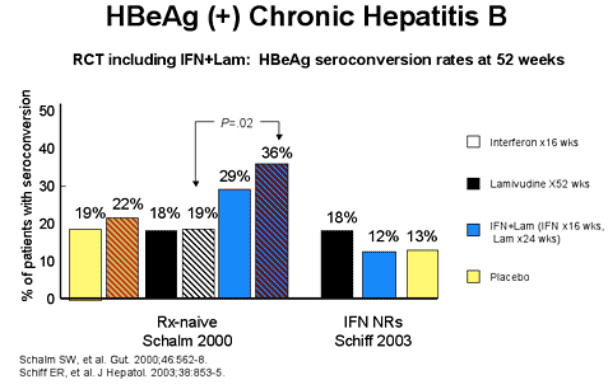
In the study by Schiff et al all patients were interferon nonresponders. There were no statistical differences in HBeAg seroconversion between patients receiving combined therapy versus lamivudine monotherapy.12
ED NOTE from Jules LevIn: HBeAg seroconversion rates were 215 after 48 weeks for patients receiving entecavir in phase III study in nucleoside-naives & 18% for lamivudine in the study. ALT notmalization was 68% for entecavir & 60% for lamivudine after 48 weeks therapy for HBeAg+ and 78% for entecavir & 71% for lamivudine for HBeAg-negatives. 67% receiving entecavir had <300 copies/ml after 48 weeks, 36% for patients receiving lamivudine, for HBeAg+. For HBeAg-negatives 90% of patients receiving entecavir and 72% receiving lamivudine achieved <300 copies/ml after 48 weeks therapy. Two-year data for entecavir is being presented at AASLD in Nov 2005. After 144 weeks adefovir therapy Marcellin reported at EASL April 2005, 53% of patients achieved HBeAg loss & 46% achieved HBeAg seroconversion. Regarding the durability of the HBeAg seroconversion, after a median duration of 55 weeks adefovir therapy, 91% of patients maintained seroconversion off therapy. For HBeAg-negative patients, 77% had ,1000 copies/ml after 192 weeks therapy with adefovir, HbsAg loss was 3.2% (4/132). ALT normalization increased to 91% after 192 weeks therapy, after 88% at week 144, 83% at week 96, and 73% after 48 weeks. Regarding drug resistance, after 4 years therapy resistance to adefovir in studies ranged from 7% to 18%, increasing incrementally each year of therapy. After 48 weeks of entecavir therapy no resistance was observed in nucleoside naive patients. At AASLD in Nov 2005 two-year data will be reported on entecavir resistance, but it is expected to be reported that no drug resistance is observed. After 1 year therapy with telbivudine (LdT), a new potent HBV drug in phase III, 4.5% drug resistance has been reported. At AASLD new data will be reported on clevudine, a new HBV drug in patientfs study.
Figure 6.
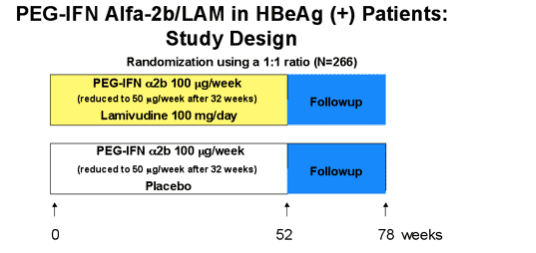
ED NOTE from Jules Levin: this study could be limited by not having a lamivudine arm for comparison.
Figure 7.

Figure 7 shows that HBeAg loss, evaluated after 1 year of treatment, occurred significantly more frequently in patients treated with combination therapy. However, at the end of posttreatment followup, the percentage of patients with a sustained HBeAg response did not differ between the two treatment groups.13
The HBV DNA response is shown in Figure 8. Patients receiving combined therapy achieved HBV DNA <200,000 copies/mL by the end of treatment significantly more frequently than the interferon monotherapy group. However, this difference was not sustained to the end of the posttreatment followup.13 An even more important indicator of the level of viral suppression is the number of individuals whose HBV DNA became negative as measured by PCR. Figure 9 shows that this occurred by the end of treatment significantly more frequently in the combined therapy group. Again, the response was not sustained through the end of followup.13
Figure 8.
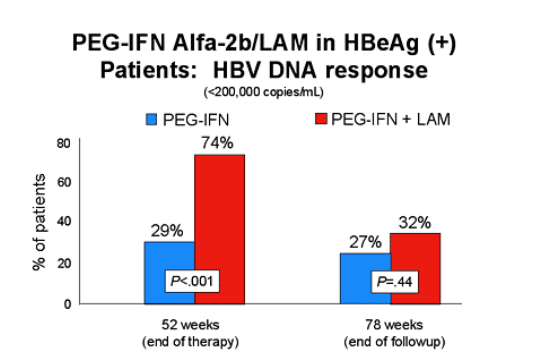
The serum HBV DNA curves are shown in Figure 10. Combined therapy resulted in a consistently greater degree of HBV DNA suppression throughout the treatment cycle. This became evident as early as week 8 and, by the end of treatment, the difference in viral suppression was nearly 3 logs.13
Figure 9.
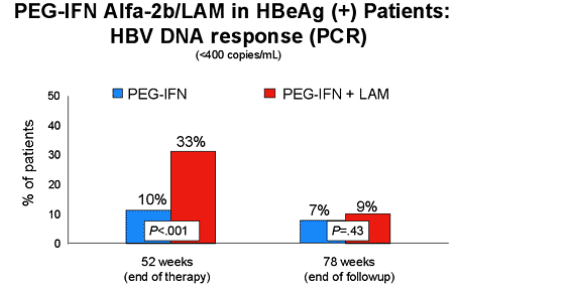
Consistent with the greater viral suppression, patients treated with combination therapy exhibited a greater decline in serum ALT. Figure 11 suggests absence of an ALT flare in the combination therapy group, with ALT levels rebounding only after withdrawal of treatment in both groups.13 The incremental change after drug discontinuation is more noticeable in the combined group, and it is unclear whether this was influenced by lamivudine withdrawal.
Figure 10.

As mentioned before, one of the major advantages of interferon versus nucleoside analogue therapy is the early HBsAg loss that occurs with interferon. In Dr Janssen's study this occurred in 5% to 7% of patients receiving interferon, and was sustained through the end of followup (Fig. 12).13
Figure 11.
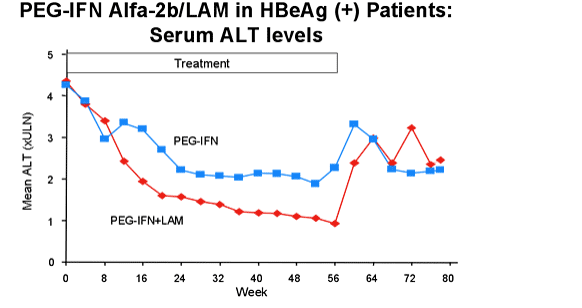
A second large multicenter trial was conducted by Marcellin and colleagues. In this study, 537 patients with HBeAg-negative chronic hepatitis B were randomized to receive 48 weeks of either pegylated interferon alfa-2a monotherapy (180 mg/week), lamivudine monotherapy (100 mg/day), or combined therapy. Followup was continued until 24 weeks after the end of treatment.14 The study design is summarized in Figure 13.
Figure 12.
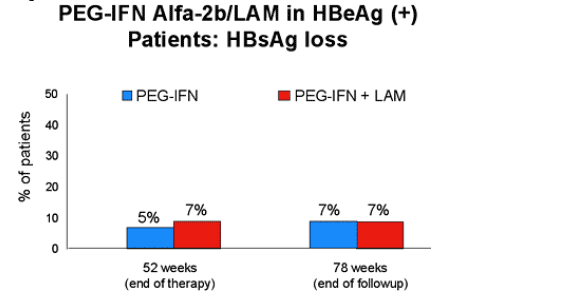
Figure 13. 537 patients with HBeAg-negative chronic hepatitis B were randomized to receive 48 weeks of either pegylated interferon alfa-2a monotherapy (180 mg/week), lamivudine monotherapy (100 mg/day), or combined therapy
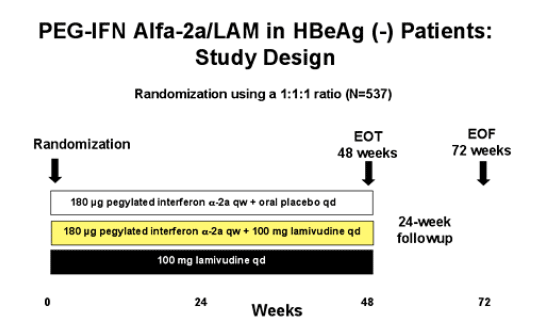
When measured at the end of followup, ALT normalization occurred in approximately 60% of both groups receiving interferon versus 44% of the lamivudine monotherapy group (Fig. 14). The differences between each interferon-containing difference between the two interferon-containing regimens.14
Figure 14.
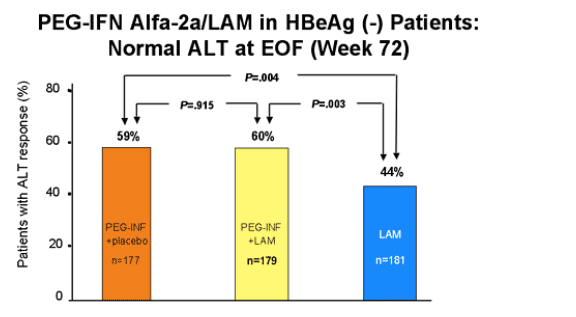
Figure 15 depicts the percentage of individuals achieving HBV DNA suppression to a level <20,000 copies/mL at the end of followup. Again, both groups receiving interferon fared better than the lamivudine monotherapy group, with no difference between the two interferon-containing regimens.14
Figure 15.
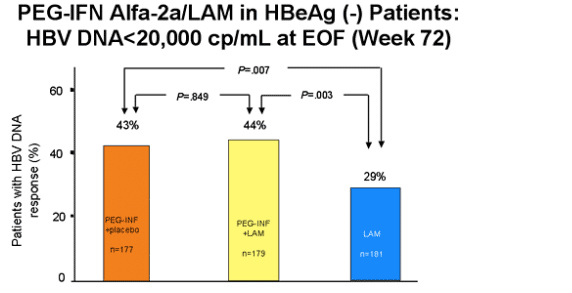
Reminiscent of the study in HBeAg-positive patients, there was a greater decline of serum HBV DNA in the combination therapy group than in either of the monotherapy groups (Fig. 16).14 Lamivudine monotherapy initially seemed to cause more rapid HBV DNA decline compared to interferon monotherapy; however, the difference between the two monotherapies was no longer evident at the end of treatment, possibly due to emergence of lamivudine-resistant mutants in the lamivudine monotherapy limb. In this study, the end-of-treatment difference in viral suppression was on the order of 1 log greater with combination therapy (in contrast to the 3-log difference seen in the study of HBeAg-positive patients).
Figure 16.
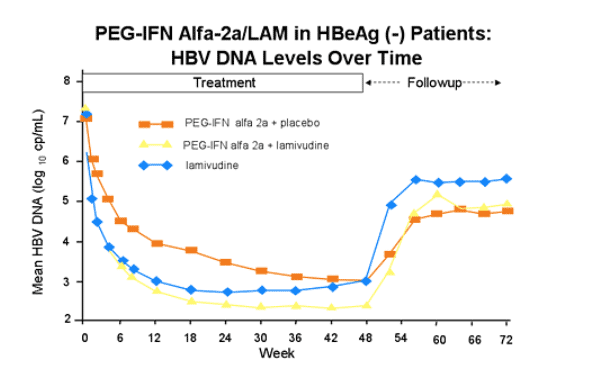
Summary
Pegylated interferon appears to be more potent than conventional interferon in the treatment of chronic hepatitis B. Combined use with nucleoside analogue therapy is associated with greater viral suppression than either agent given alone; however, sustained virologic responses have not been shown to occur any more frequently with combination therapy than with either agent alone. Future studies should address ways of maximizing sustained virologic response. Consideration should probably be given to higher and more consistent interferon dosing and possibly to altering the way in which the two drugs are combined. Theoretically, simultaneous administration of the two drugs might abrogate the immunologic response to interferon; therefore, it is possible that a lead-in phase with pegylated interferon followed by nucleoside analogue therapy might be more effective than giving the two drugs simultaneously. Finally, different dosage recommendations should be investigated for patients with unfavorable viral genotypes.
The take-home message is that interferons and nucleoside analogues work through different mechanisms of action. Although two large-scale trials have failed to show sustained differences between combination therapy and interferon monotherapy, further research is needed before discounting the possibility that combined therapy may lead to a higher rate of more lasting response.
References
1. Perrillo RP. Overview of treatment of hepatitis B: key approaches and clinical challenges. Semin Liver Dis. 2004;24 Suppl 1:23-9.
2. Keeffe EB, Dieterich DT, Han SH, et al. A treatment algorithm for the management of chronic hepatitis B virus infection in the United States. Clin Gastroenterol Hepatol. 2004 Feb;2(2):87-106.
3. Lau DT, Everhart J, Kleiner DE, et al. Long-term follow-up of patients with chronic hepatitis B treated with interferon alfa. Gastroenterology. 1997 Nov;113(5):1660-7.
4. Shiffman M, Marcellin P, Jeffers L, et al. HBsAg seroconversion in adefovir dipivoxil (ADV) treated chronic hepatitis B (CHB) patients. J Hepatol. 2004;40 (Suppl 1): 17. Abstract 45.
5. Janssen HL, Gerken G, Carreno V, et al. Interferon alfa for chronic hepatitis B infection: increased efficacy of prolonged treatment. The European Concerted Action on Viral Hepatitis (EUROHEP). Hepatology. 1999 Jul;30(1):238-43.
6. Carreno V, Marcellin P, Hadziyannis S, et al. Retreatment of chronic hepatitis B e antigen- positive patients with recombinant interferon alfa-2a. The European Concerted Action on Viral Hepatitis (EUROHEP). Hepatology. 1999 Jul;30(1):277-82.
7. Perrillo RP, Schiff ER, Davis GL, et al. A randomized, controlled trial of interferon alfa-2b alone and after prednisone withdrawal for the treatment of chronic hepatitis B. The Hepatitis Interventional Therapy Group. N Engl J Med. 1990 Aug 2;323(5):295-301.
8. Thomas HC, Karayiannis P, Brook G. Treatment of hepatitis B virus infection with interferon. Factors predicting response to interferon. J Hepatol. 1991;13 Suppl 1:S4-7.
9. Nair S, Perrillo RP. Serum alanine aminotransferase flares during interferon treatment of chronic hepatitis B: is sustained clearance of HBV DNA dependent on levels of pretreatment viremia? Hepatology. 2001 Nov;34(5):1021-6.
10. Cooksley WG, Piratvisuth T, Lee SD, et al. Peginterferon alpha-2a (40 kDa): an advance in the treatment of hepatitis B e antigen-positive chronic hepatitis B. J Viral Hepat. 2003 Jul;10(4):298- 305.
11. Schalm SW, Heathcote J, Cianciara J, et al. Lamivudine and alpha interferon combination treatment of patients with chronic hepatitis B infection: a randomised trial. Gut. 2000 Apr;46(4):562-8.
12. Schiff ER, Dienstag JL, Karayalcin S, et al. Lamivudine and 24 weeks of lamivudine/interferon combination therapy for hepatitis B e antigen-positive chronic hepatitis B in interferon nonresponders. J Hepatol. 2003 Jun;38(6):853-5.
13. Janssen HLA, Senturk H, Zeuzem S, et al. Pegylated interferon a-2b alone or in combination with lamivudine as treatment for HBeAg-positive chronic hepatitis B. Lancet (in press).
14. Marcellin P, Lau GK, Bonino F, et al. Peginterferon alfa-2a alone, lamivudine alone, and the two in combination in patients with HbeAg-negative chronic hepatitis B. N Engl J Med. 2004 Sep16;351(12):1206-17.
|
|
| |
| |
|
|
|